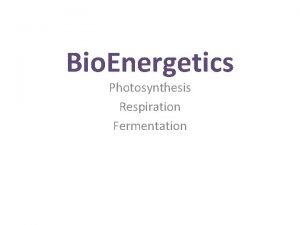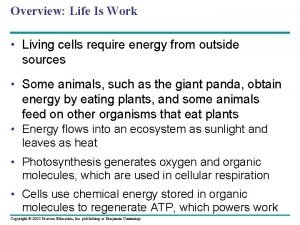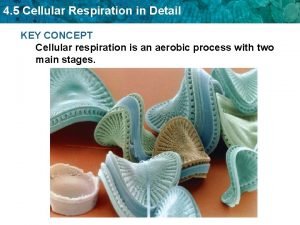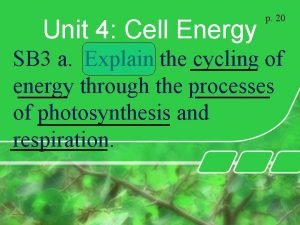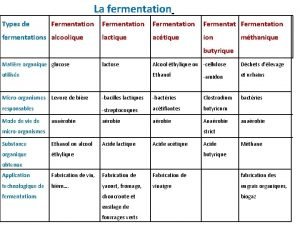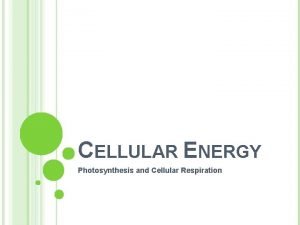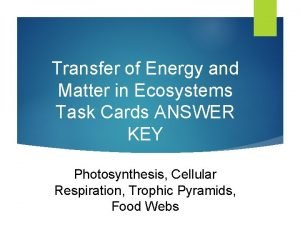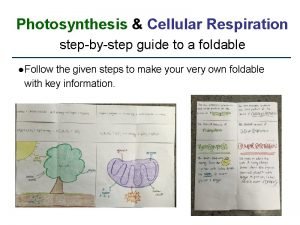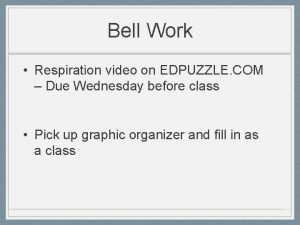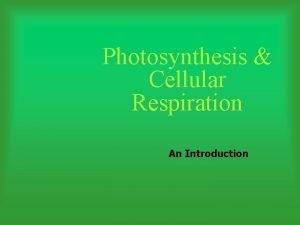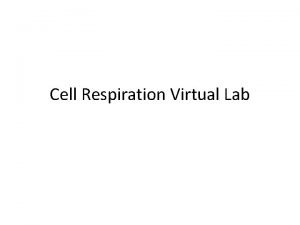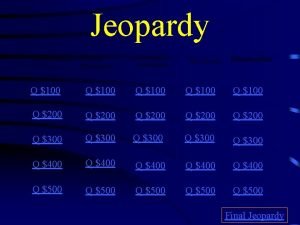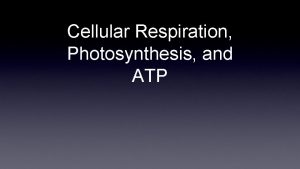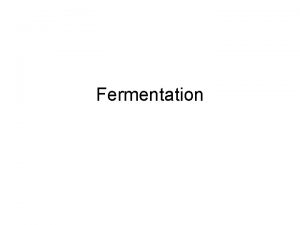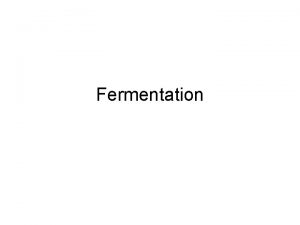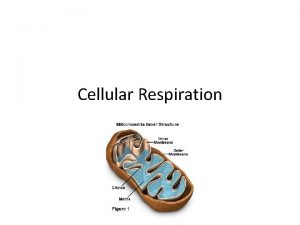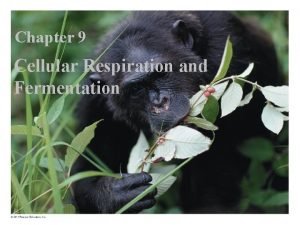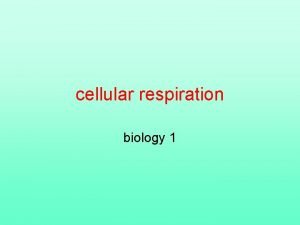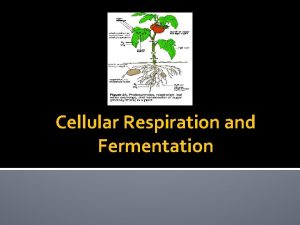Cellular Respiration And Fermentation ATP Key Concept Questions

















- Slides: 17

Cellular Respiration And Fermentation ATP

Key Concept Questions: § What is cellular respiration? § What are the two main types of § fermentation? Compare photosynthesis and cellular respiration

Energy needs of life § Animals are energy consumers u What do we need energy for? § § § Synthesis (making things) reproduction active transport movement temperature control

Where do we get energy? § Energy is stored in organic molecules § carbohydrates, fats, proteins Animals eat these organic molecules food u CALORIE u § amount of energy needed to raise the temperature of 1 gram of water 1 Celsius degree u digest food to get § fuels for energy (ATP) § raw materials for building more molecules w carbohydrates, fats, proteins, nucleic acids

What is energy in biology? ATP Whoa! Hot stuff!

Harvesting energy stored in food § Cellular respiration u breaking down food to produce ATP § in mitochondria § using oxygen glucose + oxygen carbon + water + energy dioxide C 6 H 12 O 6 + 6 O 2 6 CO 2 + 6 H 2 O + ATP + heat

What do we need to make energy? § The “Furnace” u mitochondria § Fuel u food § glucose § The Helpers u oxygen § “aerobic” u enzymes O 2 ATP

§ Respiration animation

“Burn fuels” to make energy combustion making heat energy by burning fuels in one step fuel (carbohydrates) O 2 CO 2 + H 2 O + heat respiration making ATP energy (& some heat) by burning fuels in many small steps ATP food (carbohydrates) O 2 CO 2 + H 2 O + ATP (+ heat)

Using ATP to do work? Can’t store ATP § too unstable § only used in cell that produces it § only short term energy storage § carbohydrates & fats are long term energy storage ATP work ADP + P A working muscle recycles over 10 million ATPs per second

A Body’s Energy Budget eat food ATP synthesis storage { { { • resting energy • activity • temperature control • growth • reproduction • glycogen • fat

What if oxygen is missing? § Can’t complete aerobic respiration u alcohol fermentation § yeast w glucose ATP + CO 2+ alcohol w make beer, wine, bread u lactic acid fermentation § bacteria, animals w glucose ATP + lactic acid w make yogurt w animals feel muscle fatigue but only make a little bit of ATP! O 2

§ The reactants in photosynthesis are the same as the products of cellular respiration

Key Concept Questions: § What is cellular respiration? breaking down food to produce ATP § in mitochondria § using oxygen § What are the two main types of fermentation? u alcohol fermentation wglucose ATP + CO 2+ alcohol u lactic acid fermentation wglucose ATP + lactic acid u

Key Concept Questions: § Compare photosynthesis and cellular respiration (complete the following table)

Photosynthesis Cellular Respiration Function Make food Make energy Location Chloroplasts Mitochondria Reactants CO 2 & H 20 C 6 H 12 O 6 & O 2 Products C 6 H 12 O 6 & O 2 CO 2 & H 2 O & ATP Equation 6 CO 2 + 6 H 2 O Light. C 6 H 12 O 6 + 6 O 2 + C 6 H 12 O 6 6 CO 2 + 6 H 2 O + ATP

§ Photosynthesis and Respiration comparison
 Photosynthesis ewuation
Photosynthesis ewuation Difference between autotroph and heterotroph
Difference between autotroph and heterotroph Total atp produced in cellular respiration
Total atp produced in cellular respiration Total atp produced in cellular respiration
Total atp produced in cellular respiration Concept 5 cellular respiration
Concept 5 cellular respiration Concept map cellular respiration
Concept map cellular respiration La respiration et la fermentation
La respiration et la fermentation The process of photosynthesis and cellular respiration
The process of photosynthesis and cellular respiration Reaction for cellular respiration
Reaction for cellular respiration Formula for photosynthesis and cellular respiration
Formula for photosynthesis and cellular respiration Where does cellular respiration take place
Where does cellular respiration take place Cellular respiration foldable ap biology
Cellular respiration foldable ap biology Where does the oxygen that we breathe come from edpuzzle
Where does the oxygen that we breathe come from edpuzzle Photosynthesis and cellular respiration
Photosynthesis and cellular respiration Snails and elodea virtual lab
Snails and elodea virtual lab Some students are instructed to put a celery stalk
Some students are instructed to put a celery stalk Photosynthesis and cellular respiration jeopardy
Photosynthesis and cellular respiration jeopardy Cellular respiration redox
Cellular respiration redox

